Effect of Ultrasonic Treatment on Chemical Stripping Behavior of Aluminum Coating on K6509 Co-Based Superalloy
Abstract
1. Introduction
2. Materials and Methods
3. Results
3.1. Initial Microstructure of Aluminum Coating
3.2. Corrosion Removal Test
3.3. Electrochemical Test
3.4. AFM and SKPFM Analysis
4. Discussion
4.1. Effect of Ultrasonic on the Corrosion
4.2. Corrosion Process of Aluminum Coating
5. Conclusions
Author Contributions
Funding
Data Availability Statement
Acknowledgments
Conflicts of Interest
References
- Xiong, Y.; Liu, Z.; Li, Y.; Wang, N.; Shen, J.; Lu, Y.; Li, B. Control and optimization of stray grain defect during LMC directional solidification process of single-crystal blade. J. Alloys Compd. 2025, 1021, 179742. [Google Scholar] [CrossRef]
- Dreano, A.; Fouvry, S.; Guillonneau, G. A combined friction energy and tribo-oxidation formulation to describe the high temperature fretting wear response of a cobalt-based alloy. Wear 2019, 426–427, 712–724. [Google Scholar] [CrossRef]
- Michel, G.; Berthod, P.; Vilasi, M.; Mathieu, S.; Steinmetz, P. Protection of cobalt-based refractory alloys by chromium deposition on surface: Part II: Behaviour of the coated alloys in oxidation at high temperature. Surf. Coat. Technol. 2011, 205, 5241–5247. [Google Scholar] [CrossRef]
- Makineni, S.K.; Samanta, A.; Rojhirunsakool, T.; Alam, T.; Nithin, B.; Singh, A.K.; Banerjee, R.; Chattopadhyay, K. A new class of high strength high temperature Cobalt based γ–γ′ Co–Mo–Al alloys stabilized with Ta addition. Acta Mater. 2015, 97, 29–40. [Google Scholar] [CrossRef]
- Shao, Q.; Lyu, B.; Yuan, J.; Wang, X.; Ke, M.; Zhao, P. Shear thickening polishing of the concave surface of high-temperature nickel-based alloy turbine blade. J. Mater. Res. Technol. 2021, 11, 72–84. [Google Scholar] [CrossRef]
- Meng, J.; Zhao, E.; Li, X.; Liao, K.; Li, J.; Fang, H.; Han, Q.; Ma, S.; Zhao, H.; Zhang, J. Quantitative evaluation of fatigue cracks on compressor blades using laser ultrasonic technology under high-temperature conditions. NDT E Int. 2025, 154, 103402. [Google Scholar] [CrossRef]
- Palmert, F.; Gustafsson, D.; Almroth, P.; Petersson, H.; Segersäll, M.; Moverare, J. Modelling of the transition from mode I to crystallographic crack growth in a single crystal gas turbine blade alloy under service-like loading conditions. Int. J. Fatigue 2022, 163, 107077. [Google Scholar] [CrossRef]
- Khushbash, S.; Hameed, A.; Mumtaz, A.; Ali Khan, H.; Shahzad, A. Investigation of temperature assisted corrosion failure of an aircraft turbine blade. Eng. Fail. Anal. 2025, 167, 108909. [Google Scholar] [CrossRef]
- Wang, C.; Shang, Y.; Zhou, L.; Zhao, Z.; Zhang, X.; Wang, L.; Li, B.; He, W.; Chen, W. High cycle fatigue limit assessment of foreign object damaged aerofoil blades considering the residual stress induced by impact. Eng. Fract. Mech. 2025, 318, 110993. [Google Scholar] [CrossRef]
- Liu, J.; Li, Q.; Xie, Y.; Luo, J.; Zhang, C.; Wang, W.; Cao, K.; Liang, X.; Yang, L.; Zhou, Y. Microstructural evolution mechanism of aluminide coating on the inner hollow of superalloy blades during service in a real gas turbine. J. Mater. Sci. Technol. 2025, 239, 55–69. [Google Scholar] [CrossRef]
- Tytko, G.; Adamczyk-Habrajska, M.; Li, Y.; Liu, Z.; Kopec, M. High frequency eddy current method in inspection of aluminide coatings integrity after simulating service loads. Measurement 2025, 252, 117356. [Google Scholar] [CrossRef]
- Sarraf, S.; Soltanieh, M.; Rastegari, S. Isothermal oxidation performance at 1000 °C of two different aluminide coatings deposited by the reactive air aluminizing (RAA) method on a nickel-based superalloy (IN738LC). J. Alloys Compd. 2025, 1010, 178123. [Google Scholar] [CrossRef]
- Vermaak, N.; Mottura, A.; Pollock, T.M. Cyclic oxidation of high temperature coatings on new γ′-strengthened cobalt-based alloys. Corros. Sci. 2013, 75, 300–308. [Google Scholar] [CrossRef]
- Li, D.; Lu, P.; Li, Z.; Zhang, W.; Hua, T.; Fan, X. Creep life modelling of nickel-based single crystal superalloy DD6 with MCrAlY coating. Eng. Fract. Mech. 2024, 306, 110194. [Google Scholar] [CrossRef]
- Kang, J.; Liu, Y.; Zhou, J.; Zhuo, W.; Zhang, J.; Zeng, J.; Zhang, H.; Pei, Y.; Li, S.; Gong, S. Temperature-dependent evolution mechanism of interface microstructure between gradient MCrAlY coatings and nickel-based superalloy. Mater. Des. 2024, 237, 112585. [Google Scholar] [CrossRef]
- Li, Q.; Cui, X.; Jing, Y.; Xu, W.; Wang, Y.; Chen, Z.; Zhang, Z.; Fang, Y.; Shang, T.; Jin, G. Multi-interface modification induced crack deflection behavior and enhanced fracture resistance in thermal barrier coatings. J. Alloys Compd. 2025, 1031, 181027. [Google Scholar] [CrossRef]
- Lv, X.; Li, D.; Duan, W.; Li, C.; Huang, B.; Qiang, W. Comprehensive study of the effect of Hf and Ta co-doped MCrAlY bond coat on the high-temperature properties of thermal barrier coating. Surf. Interfaces 2024, 54, 105277. [Google Scholar] [CrossRef]
- Vialas, N.; Monceau, D. Effect of Pt and Al content on the long-term, high temperature oxidation behavior and interdiffusion of a Pt-modified aluminide coating deposited on Ni-base superalloys. Surf. Coat. Technol. 2006, 201, 3846–3851. [Google Scholar] [CrossRef]
- Xu, Z.; Dai, J.; Niu, J.; He, L.; Mu, R.; Wang, Z. Isothermal oxidation and hot corrosion behaviors of diffusion aluminide coatings deposited by chemical vapor deposition. J. Alloys Compd. 2015, 637, 343–349. [Google Scholar] [CrossRef]
- Meng, G.-H.; Wang, Y.-N.; Gui, P.-P.; Li, S.-S.; Wang, W.-J.; Guo, K.-Y.; Yang, G.-J. Improving oxidation resistance of aluminide coatings by alloying elements from underlying superalloys. Corros. Sci. 2025, 242, 112568. [Google Scholar] [CrossRef]
- Elsaß, M.; Frommherz, M.; Scholz, A.; Oechsner, M. Interdiffusion in MCrAlY coated nickel-base superalloys. Surf. Coat. Technol. 2016, 307, 565–573. [Google Scholar] [CrossRef]
- Meng, G.-H.; Li, S.-S.; Wang, Y.-N.; Gui, P.-P.; Zhang, M.-Y.; Guo, K.-Y.; Liu, M.-J.; Yang, G.-J. Unraveling β-NiAl degradation in aluminide coatings: A comparative study of isothermal oxidation and vacuum heat treatment. Corros. Sci. 2025, 251, 112946. [Google Scholar] [CrossRef]
- Texier, D.; Monceau, D.; Hervier, Z.; Andrieu, E. Effect of interdiffusion on mechanical and thermal expansion properties at high temperature of a MCrAlY coated Ni-based superalloy. Surf. Coat. Technol. 2016, 307, 81–90. [Google Scholar] [CrossRef]
- Genova, V.; Pedrizzetti, G.; Paglia, L.; Marra, F.; Bartuli, C.; Pulci, G. Diffusion aluminide coating modified via electroless nickel plating for Ni-based superalloy protection. Surf. Coat. Technol. 2022, 439, 128452. [Google Scholar] [CrossRef]
- Chondrakis, G.; Tzanis, A.; Georgiou, E.; Koutsomichalis, A. Root cause analysis of turboprop engine Inconel 713LC turbine blades failure. Eng. Fail. Anal. 2025, 176, 109609. [Google Scholar] [CrossRef]
- Yang, X.; Wang, M.; Shi, D.; Li, Z.; Fan, Y. A multi-scale framework for life reduction assessment of turbine blade caused by microstructural degradation. Chin. J. Aeronaut. 2024, 37, 186–200. [Google Scholar] [CrossRef]
- Denkena, B.; Nyhuis, P.; Bergmann, B.; Nübel, N.; Lucht, T. Towards an autonomous maintenance, repair and overhaul process: Exemplary holistic data management approach for the regeneration of aero-engine blades. Procedia Manuf. 2019, 40, 77–82. [Google Scholar] [CrossRef]
- Le Guével, Y.; Grégoire, B.; Cristóbal, M.J.; Feaugas, X.; Oudriss, A.; Pedraza, F. Dissolution and passivation of aluminide coatings on model and Ni-based superalloy. Surf. Coat. Technol. 2019, 357, 1037–1047. [Google Scholar] [CrossRef]
- Guha, A.; Barron, R.M.; Balachandar, R. An experimental and numerical study of water jet cleaning process. J. Mater. Process. Technol. 2011, 211, 610–618. [Google Scholar] [CrossRef]
- Jafari Eskandari, M.; Karimi, M.; Araghchi, M.; Hadipour, A. Laser cleaning process of high-pressure turbine blade: Characterization and removal of surface contaminants. Surf. Coat. Technol. 2023, 470, 129885. [Google Scholar] [CrossRef]
- Nie, J.; Zhang, H.; Zhang, D.; Su, X.; Zhang, J.; Shan, D.; Guo, B.; Xu, J. Laser-induced removal of thermal control coatings on aluminum alloy surfaces: Thermal-impact coupling effects and processes. Appl. Surf. Sci. 2025, 706, 163524. [Google Scholar] [CrossRef]
- Cano-Salinas, L.; Sourd, X.; Moussaoui, K.; Le Roux, S.; Salem, M.; Hor, A.; Zitoune, R. Effect of process parameters of Plain Water Jet on the cleaning quality, surface and material integrity of Inconel 718 milled by Abrasive Water Jet. Tribol. Int. 2023, 178, 108094. [Google Scholar] [CrossRef]
- Nie, J.; Zhang, H.; Zhang, D.; Xu, J.; Zhang, J.; Shan, D.; Guo, B. Removal mechanism of laser cleaning for inorganic thermal control coatings on aluminum alloys. Appl. Surf. Sci. 2023, 633, 157578. [Google Scholar] [CrossRef]
- Wang, Y.; Yang, Y.; Qu, J.; Cui, C. Electrochemical dissolution of MCrAlY coatings and oxide layers on Ni-based superalloys in 3.5% NaCl and aqua-regia solutions. Int. J. Electrochem. Sci. 2024, 19, 100451. [Google Scholar] [CrossRef]
- Bouchaud, B.; Creus, J.; Rébéré, C.; Balmain, J.; Pedraza, F. Controlled stripping of aluminide coatings on nickel superalloys through electrolytic techniques. J. Appl. Electrochem. 2008, 38, 817–825. [Google Scholar] [CrossRef]
- Zhang, C.Y.; Li, S.; Huang, D.; Jiang, Y.M.; Jiang, C.Y.; Bao, Z.B.; Zhu, S.L.; Wang, F.H. Investigation on the tensile behavior of refurbished (Ni,Pt)Al coated Ni-based superalloy. J. Alloys Compd. 2025, 1020, 179560. [Google Scholar] [CrossRef]
- Zhang, C.Y.; Ma, Z.; Dong, S.Z.; Xu, M.M.; Li, S.; Zhang, C.; Jiang, C.Y.; Bao, Z.B.; Zhu, S.L.; Wang, F.H. High-temperature oxidation behaviour of refurbished (Ni,Pt)Al coating on Ni-based superalloy at 1100 °C. Corros. Sci. 2021, 187, 109521. [Google Scholar] [CrossRef]
- Poupard, S.; Martinez, J.F.; Pedraza, F. Soft chemical stripping of aluminide coatings and oxide products on Ni superalloys. Surf. Coat. Technol. 2008, 202, 3100–3108. [Google Scholar] [CrossRef]
- Alam, M.Z.; Sarkar, S.B.; Das, D.K. Refurbishment of thermally degraded diffusion Pt-aluminide (PtAl) bond coat on a Ni-base superalloy. Surf. Coat. Technol. 2018, 354, 101–111. [Google Scholar] [CrossRef]
- Boulesteix, C.; Grégoire, B.; Pedraza, F. Oxidation performance of repaired aluminide coatings on austenitic steel substrates. Surf. Coat. Technol. 2017, 326, 224–237. [Google Scholar] [CrossRef]
- Wang, J.; Ji, H.; Chen, M.; Bao, Z.; Zhu, S.; Wang, F. High temperature oxidation and interdiffusion behavior of recoated NiCoCrAlY coating on a nickel-based superalloy. Corros. Sci. 2020, 175, 108894. [Google Scholar] [CrossRef]
- Shao, M.; Mo, W.; Wu, Y.; Sun, Q.; Xia, S.; Wang, Y.; Fang, H.; Nishimura, K. Research on the microstructure and diffusion behavior of CVD aluminide coatings on inconel 718 superalloy. Vacuum 2024, 228, 113541. [Google Scholar] [CrossRef]
- Zhen, W.; Wen, Z.; Jing, Z.; Chang, L.; Zhen, Z.; Shi, Q.; Chun, T. Microstructure Evolution of K6509 Cobalt-base Superalloy for Over-temperature. Procedia Eng. 2015, 99, 1302–1310. [Google Scholar] [CrossRef]
- Berthod, P.; Conrath, E. As-cast microstructures and behavior at high temperature of chromium-rich cobalt-based alloys containing hafnium carbides. Mater. Chem. Phys. 2014, 143, 1139–1148. [Google Scholar] [CrossRef]
- Bairi, L.R.; Bairagi, D.; Duley, P.; Mandal, S. Effect of Long-Term Immersion on the Corrosion and Passivation Behavior of Lean Duplex Stainless Steel 2101 in 3.5 wt% NaCl Solution. Met. Mater. Int. 2023, 29, 1923–1939. [Google Scholar] [CrossRef]
- Kong, W.; Li, K.; Hu, J. Immersion corrosion behavior, electrochemical performance and corrosion mechanism of subsonic flame sprayed FeCoCrMoSi amorphous coating in 3.5% NaCl solution. Int. J. Hydrogen Energy 2022, 47, 6911–6923. [Google Scholar] [CrossRef]
- Li, L.; Huang, T.; Zhang, D.; Chen, R.; Hua, C.; Tan, X.; Ren, K.; Song, P. Effect of pre-oxidation on the electrochemical corrosion behavior of Ni-based coating reinforced by ceramic particles. Ceram. Int. 2023, 49, 18095–18103. [Google Scholar] [CrossRef]
- Zhao, Y.; Zhang, T.; Xiong, H.; Wang, F. Bridge for the thermodynamics and kinetics of electrochemical corrosion: Modeling on dissolution, ionization, diffusion and deposition in metal/solution interface. Corros. Sci. 2021, 191, 109763. [Google Scholar] [CrossRef]
- Rahimi, E.; Nijdam, T.; Jahagirdar, A.; Broitman, E.; Mol, A. A combined microstructural, electrochemical and nanomechanical study of the corrosion and passivation properties of a Cr/CrN multilayer coating. Corros. Sci. 2025, 252, 112943. [Google Scholar] [CrossRef]
- Shao, M.; Mo, W.; Wu, Y.; Sun, Q.; Xia, S.; Wang, Y.; Fang, H. Temperature-dependent and duration-dependent effect on the growth behavior of CVD aluminide coating on K452 superalloy. Vacuum 2024, 220, 112862. [Google Scholar] [CrossRef]
- Lei, C.; Jacobson, B.; Hartley, J.M.; Scott, S.; Sumarlan, I.; Feeney, A.; Prentice, P.; Ryder, K.S.; Abbott, A.P. Effect of organic solvent additives on the enhancement of ultrasonic cavitation effects in water for lithium-ion battery electrode delamination. Ultrason. Sonochem 2024, 110, 107049. [Google Scholar] [CrossRef]
- Halder, S.; Vinay, G.; Anupam, A.; Ang, A.S.M.; Mahajan, D.K.; Singh, H. Effect of prolonged immersion on corrosion and cavitation resistance of HVOF-sprayed WC-NiCr and WC-Hastelloy cermet coatings. Surf. Coat. Technol. 2024, 494, 131384. [Google Scholar] [CrossRef]
- Wang, X.; Zhang, L.; Wei, Z.; Zhang, Y.; Wang, C.; Hong, S. Enhanced ultrasonic cavitation erosion and corrosion resistances of carbide-based composite coatings by graphene. Ultrason. Sonochem. 2025, 120, 107425. [Google Scholar] [CrossRef] [PubMed]
- Shi, X.; Cui, D.; Wei, Z.; Hong, S. The influence of sulphide on the ultrasonic cavitation erosion-corrosion behaviors of HVOF-sprayed WC-Cr3C2-Ni coating. Ultrason. Sonochem 2023, 100, 106629. [Google Scholar] [CrossRef] [PubMed]
- Souissi, M.; Sluiter, M.H.F.; Matsunaga, T.; Tabuchi, M.; Mills, M.J.; Sahara, R. Direct observation and modeling of growth-induced stacking fault in chromium-rich γ-M23C6 carbides. Scr. Mater. 2020, 178, 290–294. [Google Scholar] [CrossRef]
- Biranvand, K.H.; Vaezi, M.; Razavi, M. Thermodynamic study on the formation of order-disorder structure of the NiAl intermetallic compound by semi-empirical model. Phys. B Condens. Matter 2019, 561, 43–53. [Google Scholar] [CrossRef]
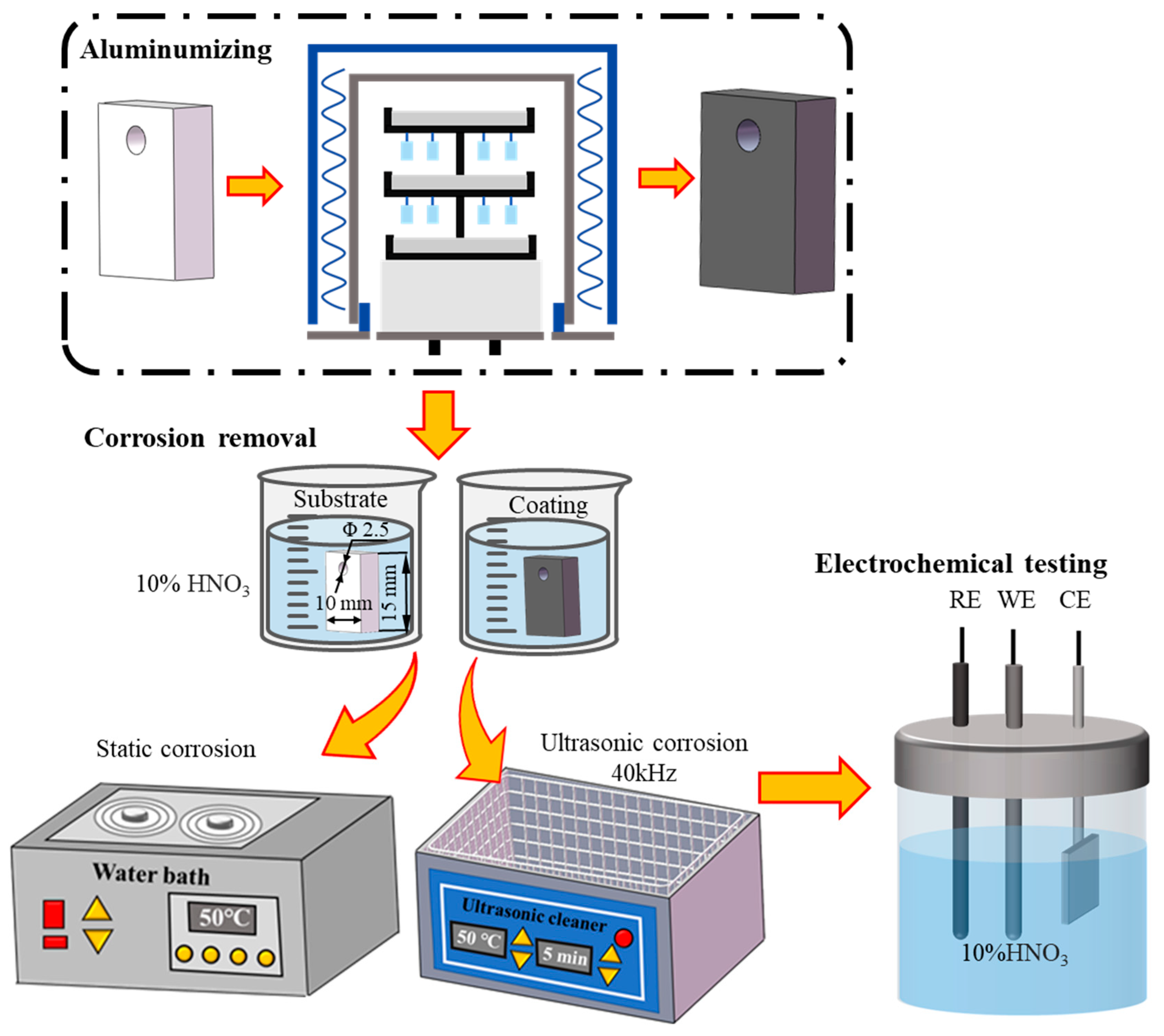
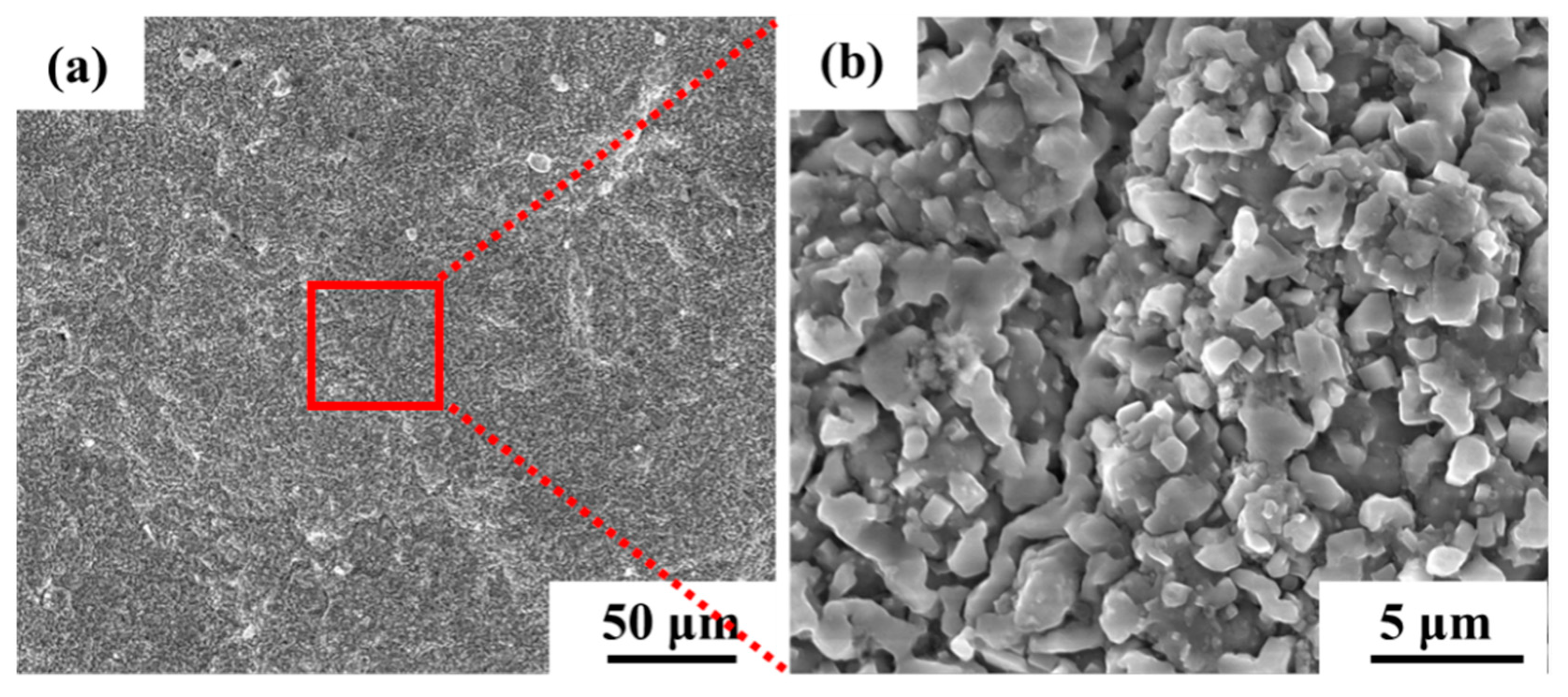
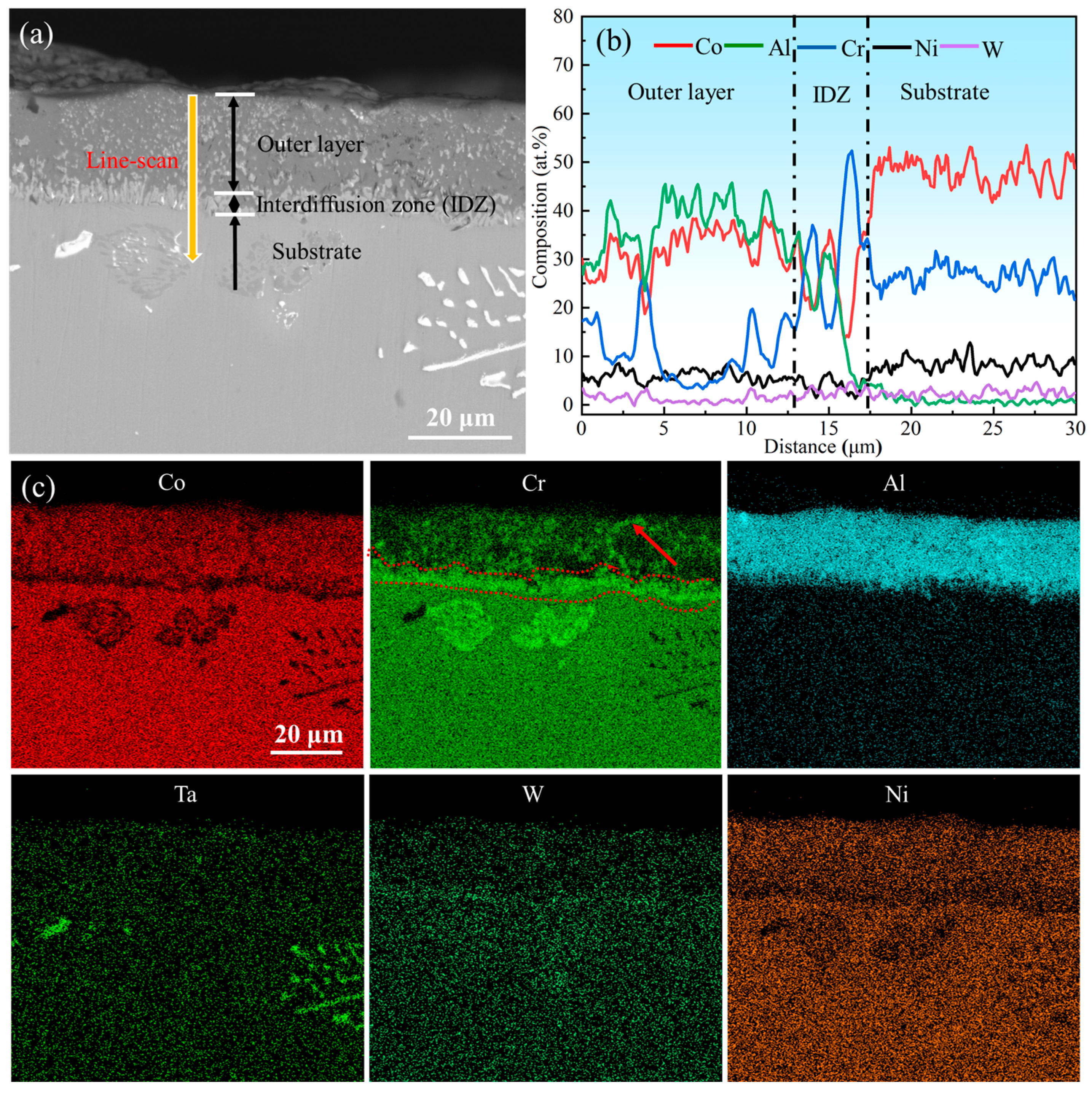
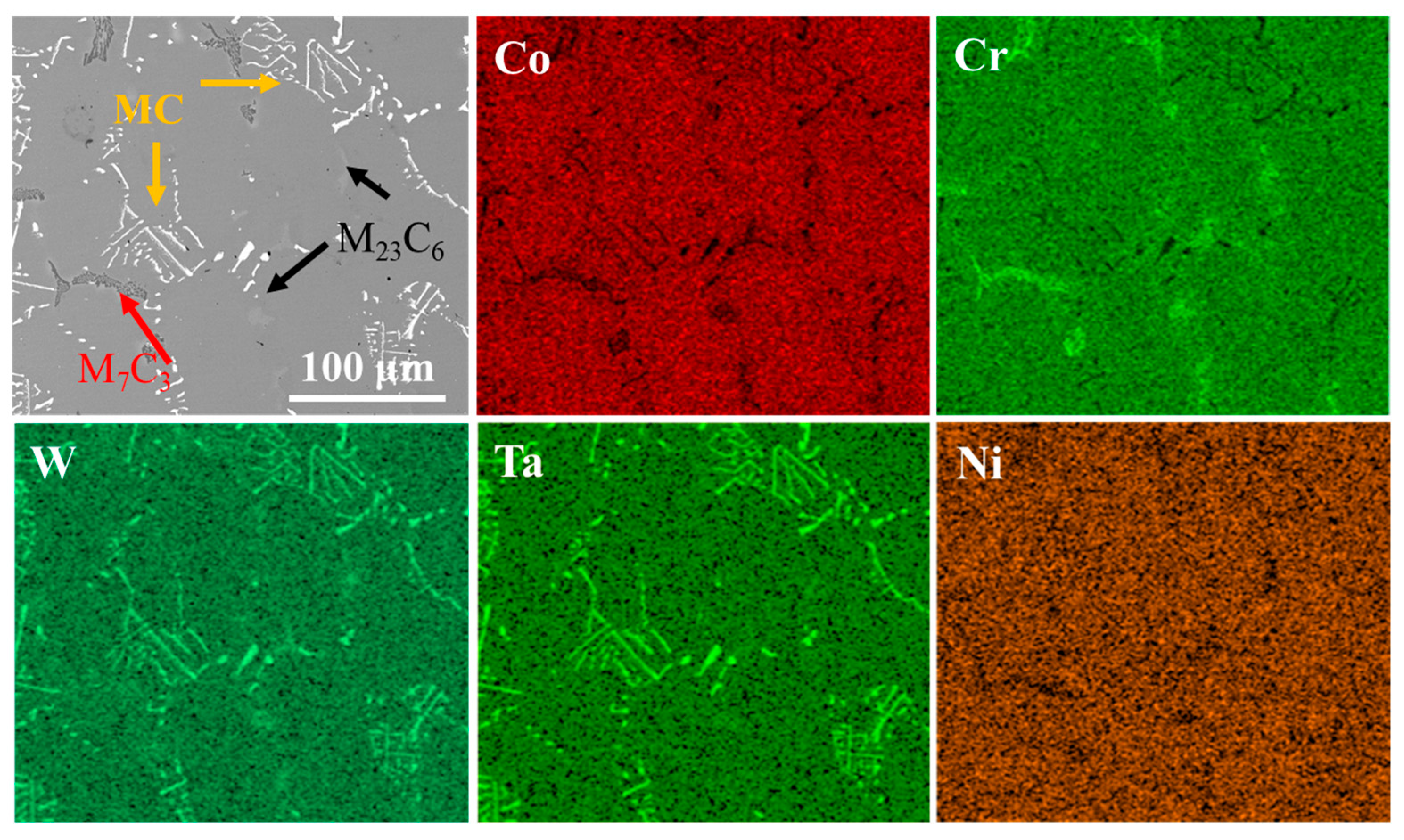
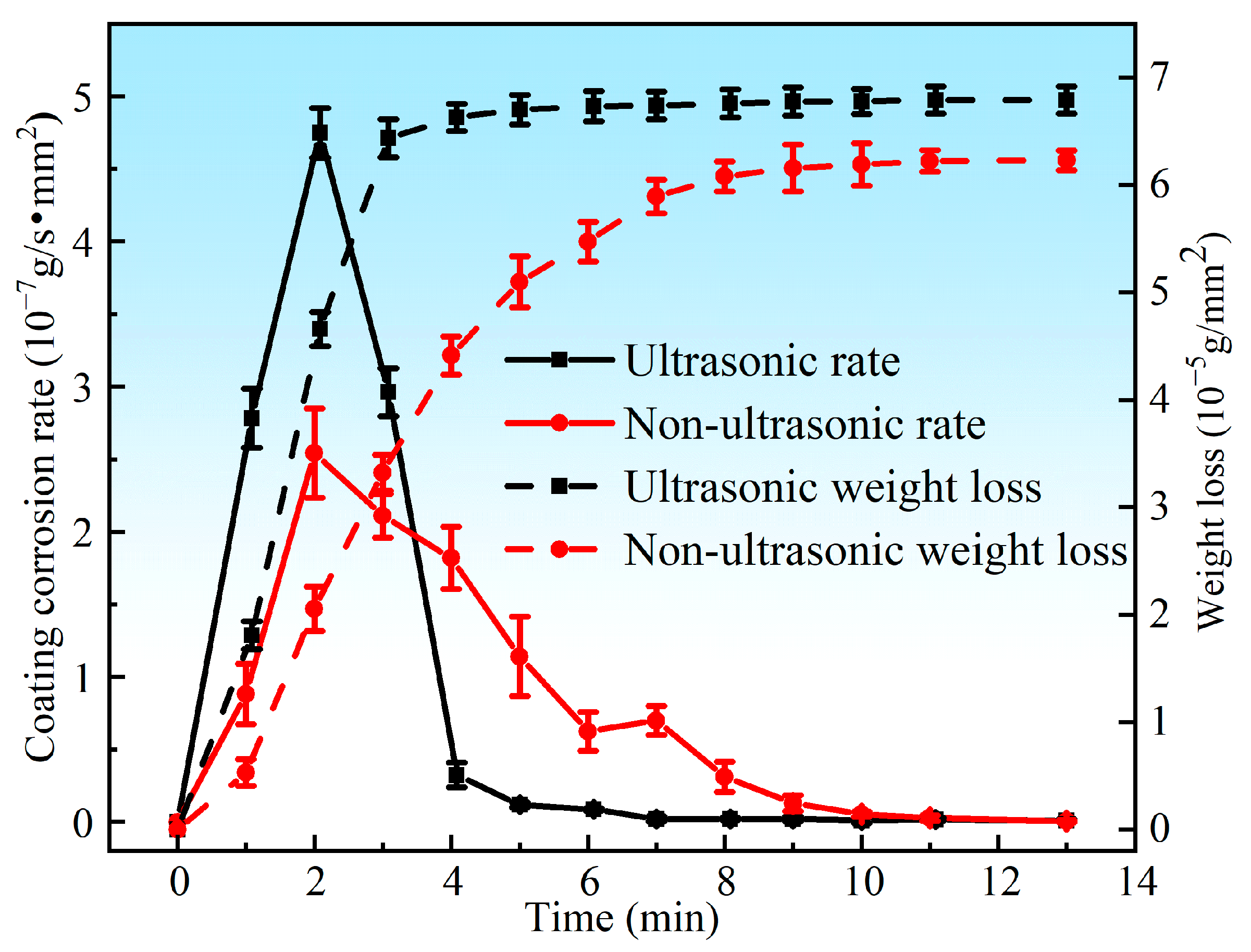
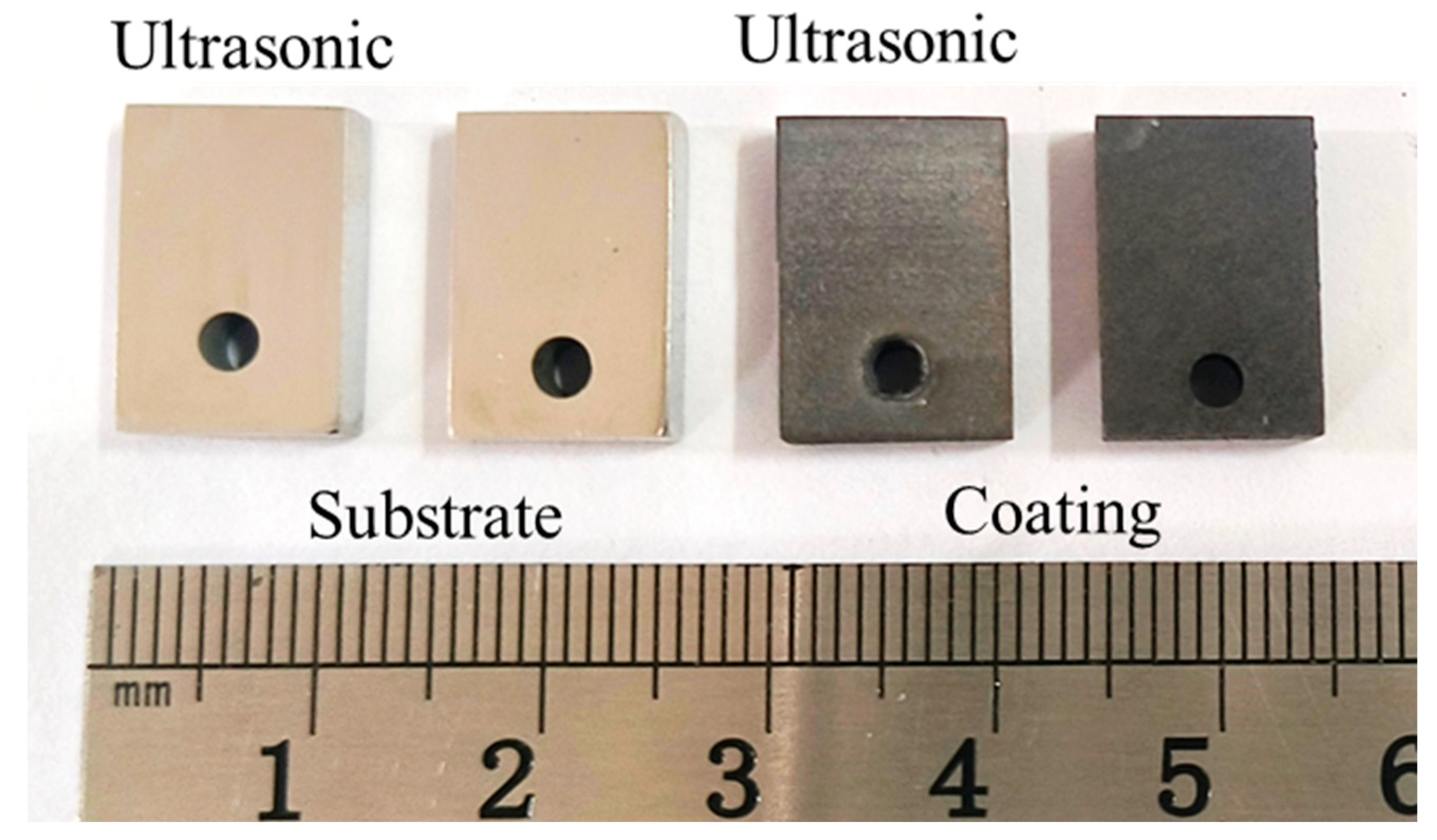
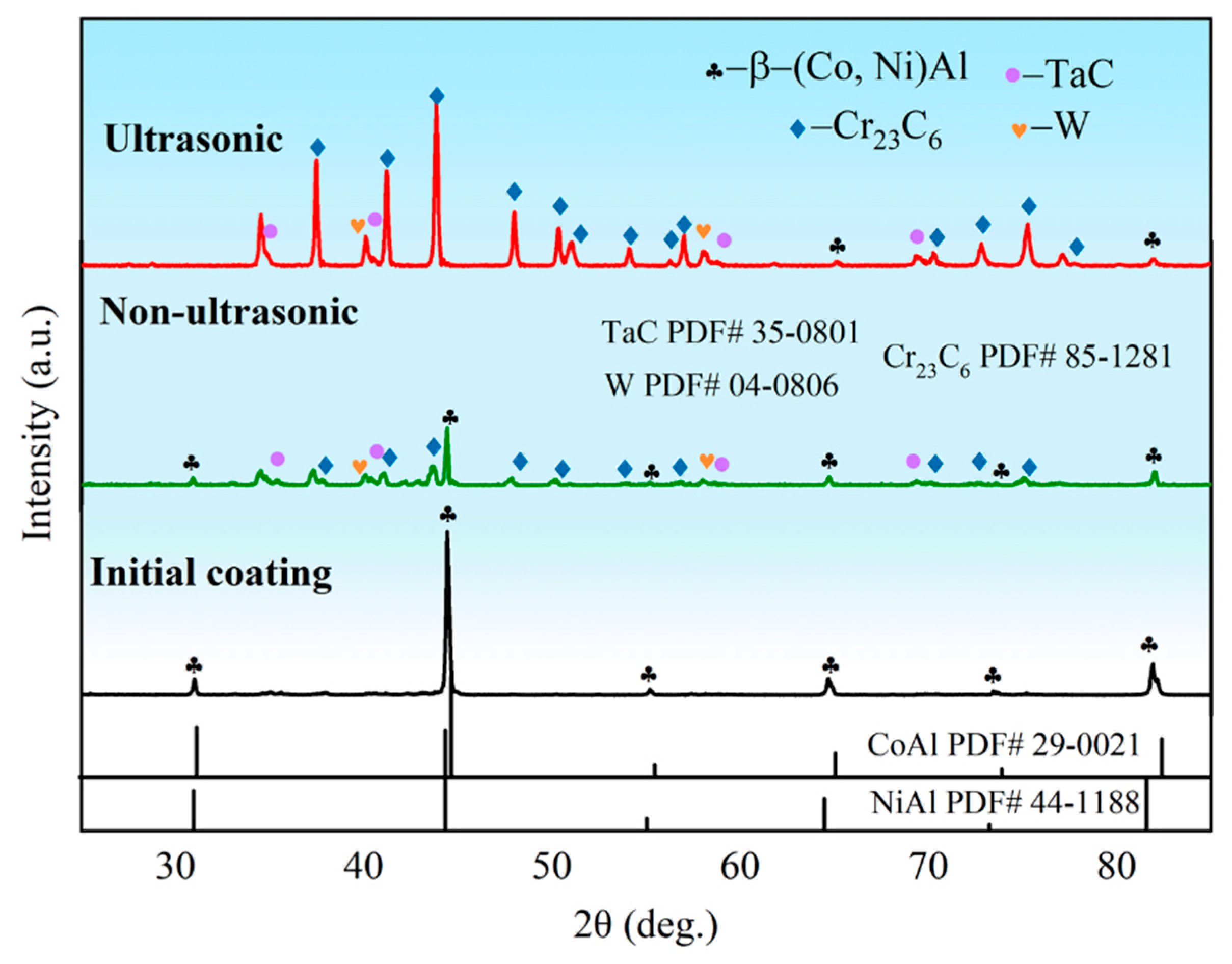
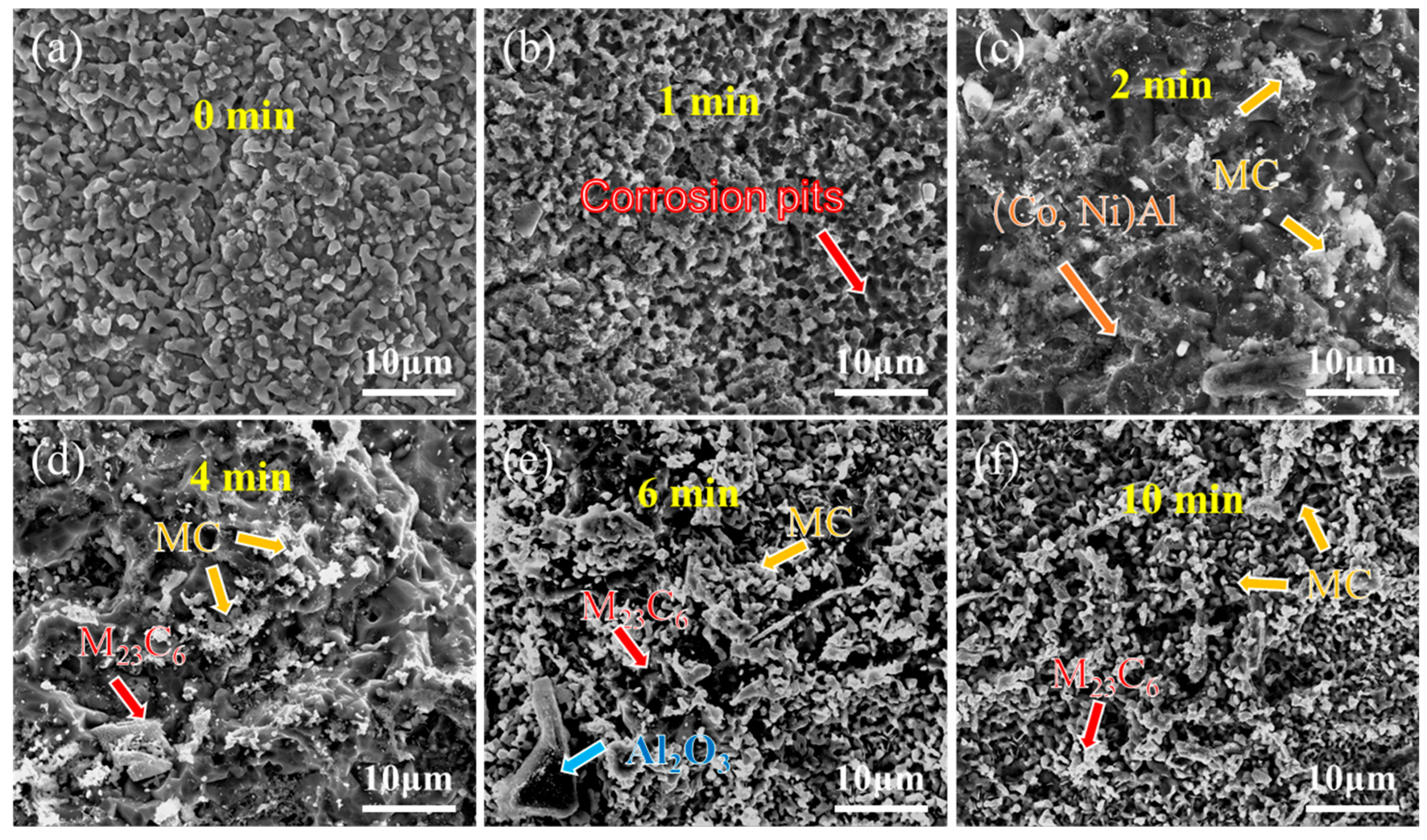
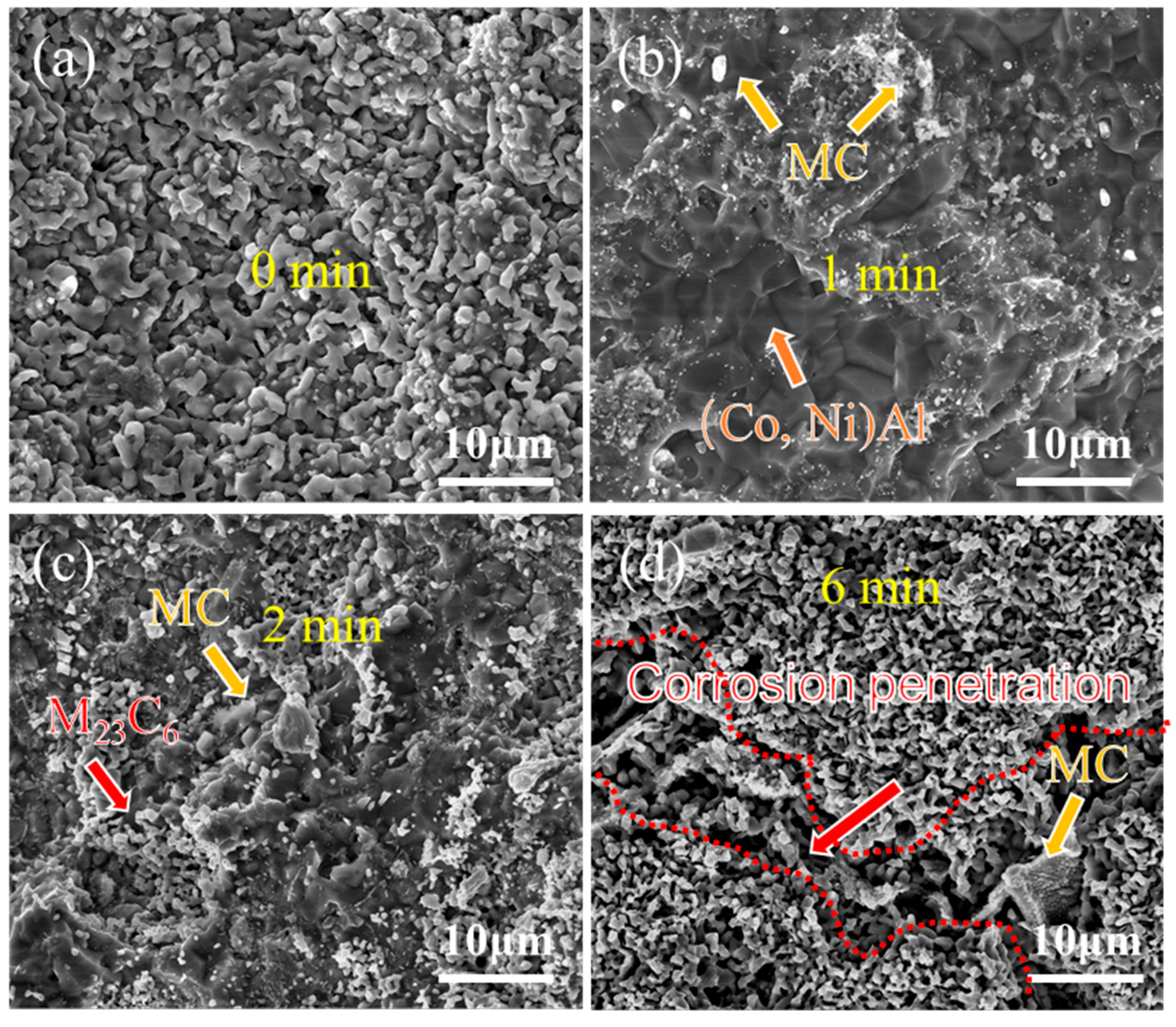
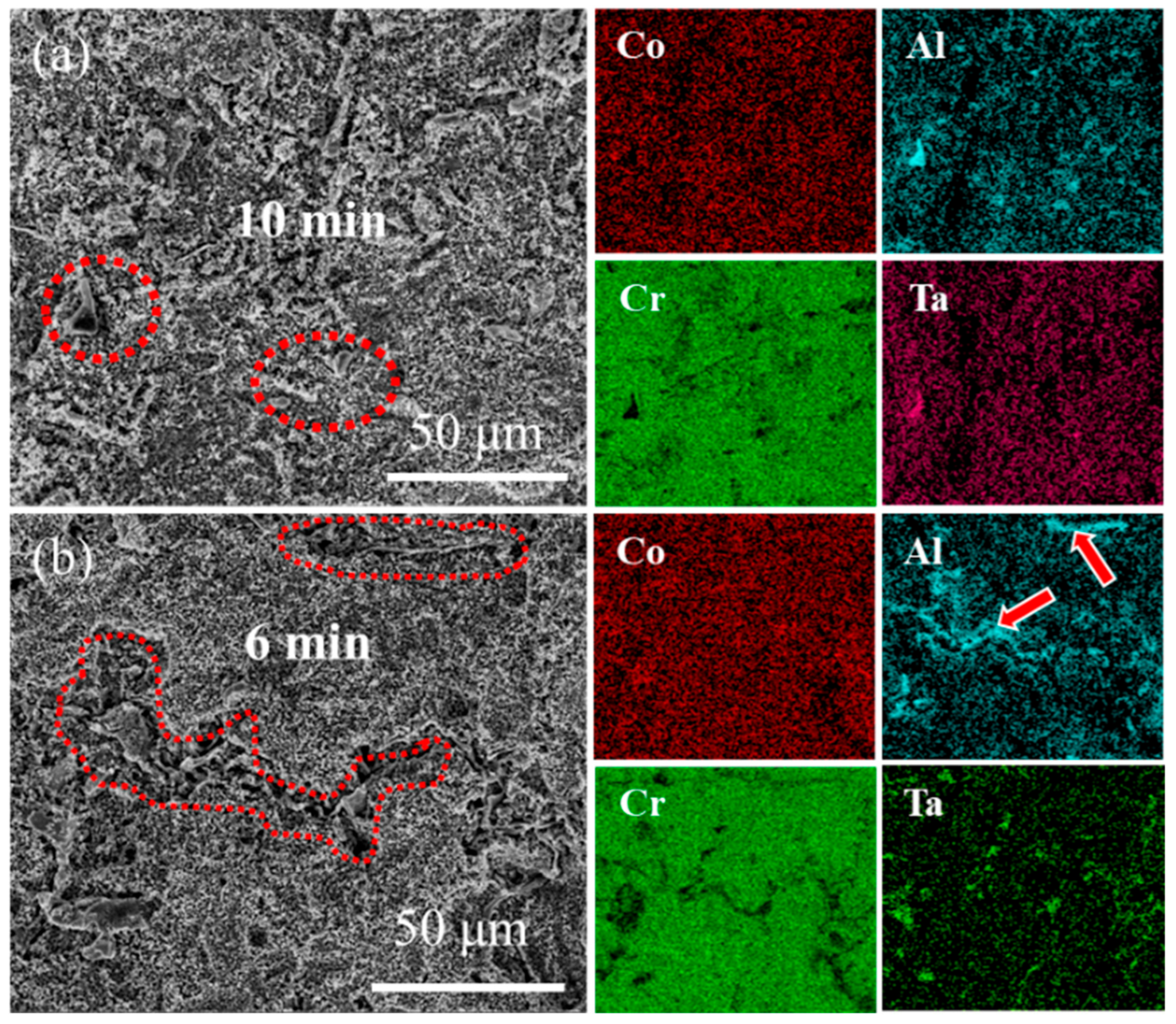
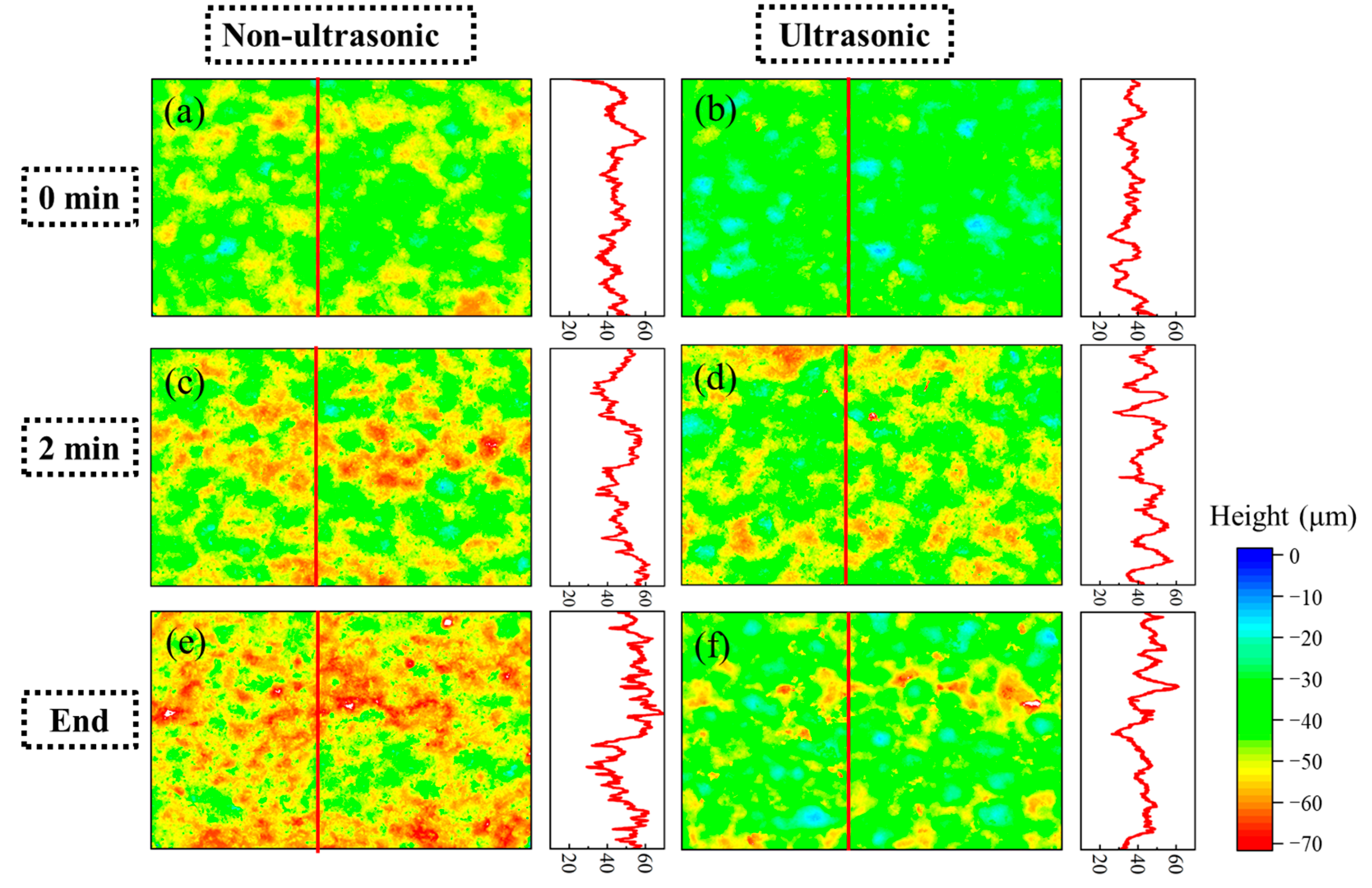
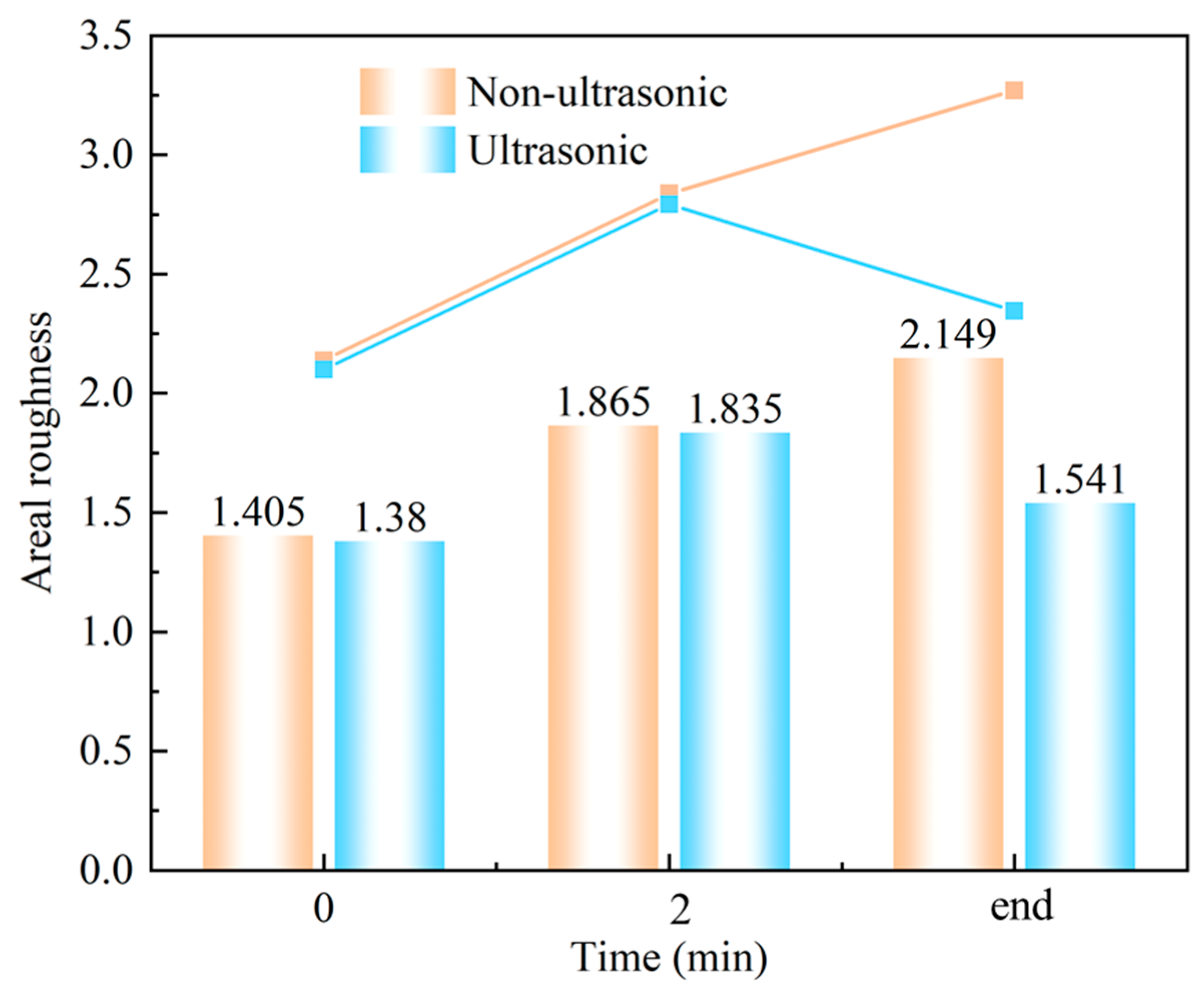
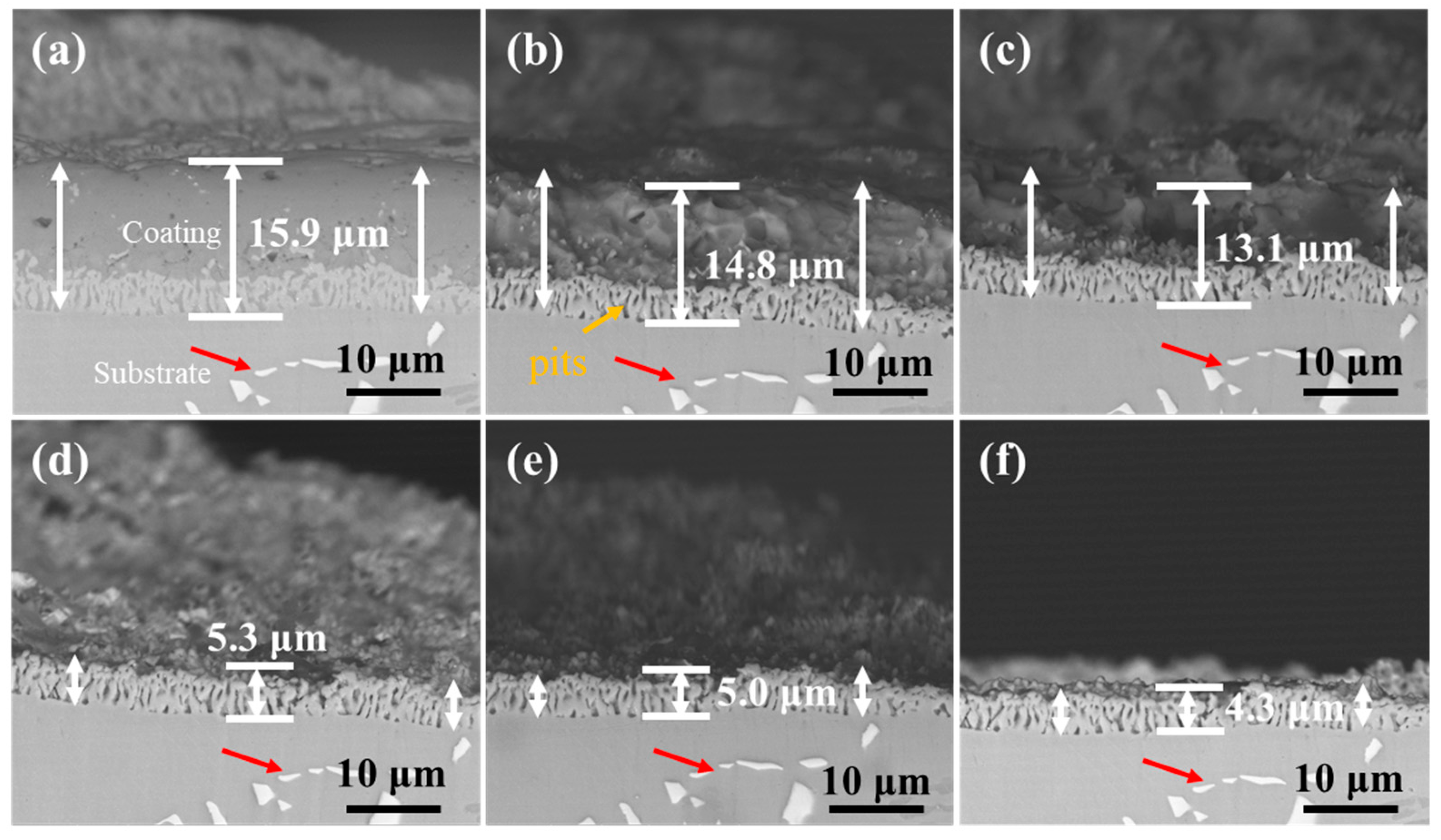
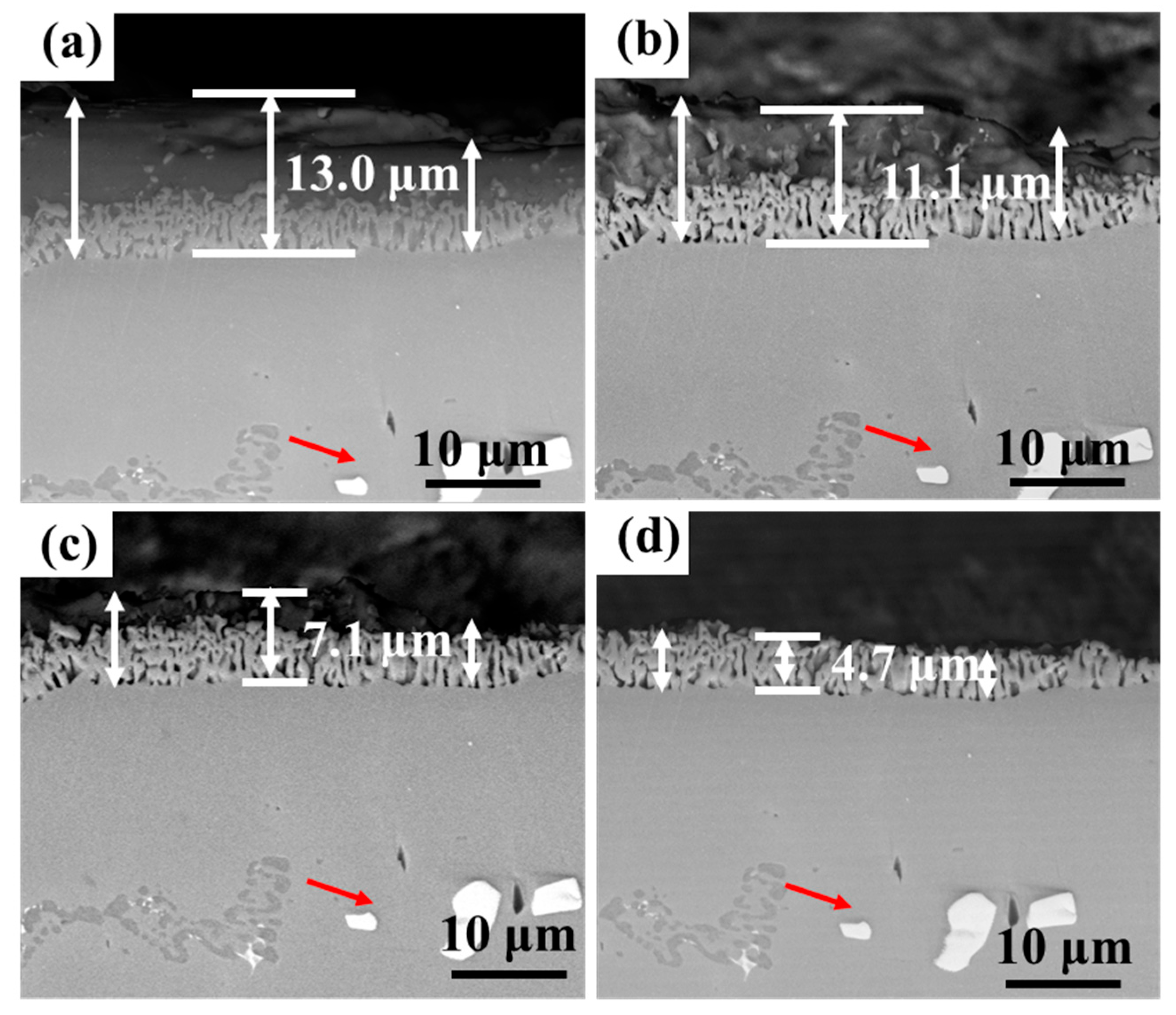
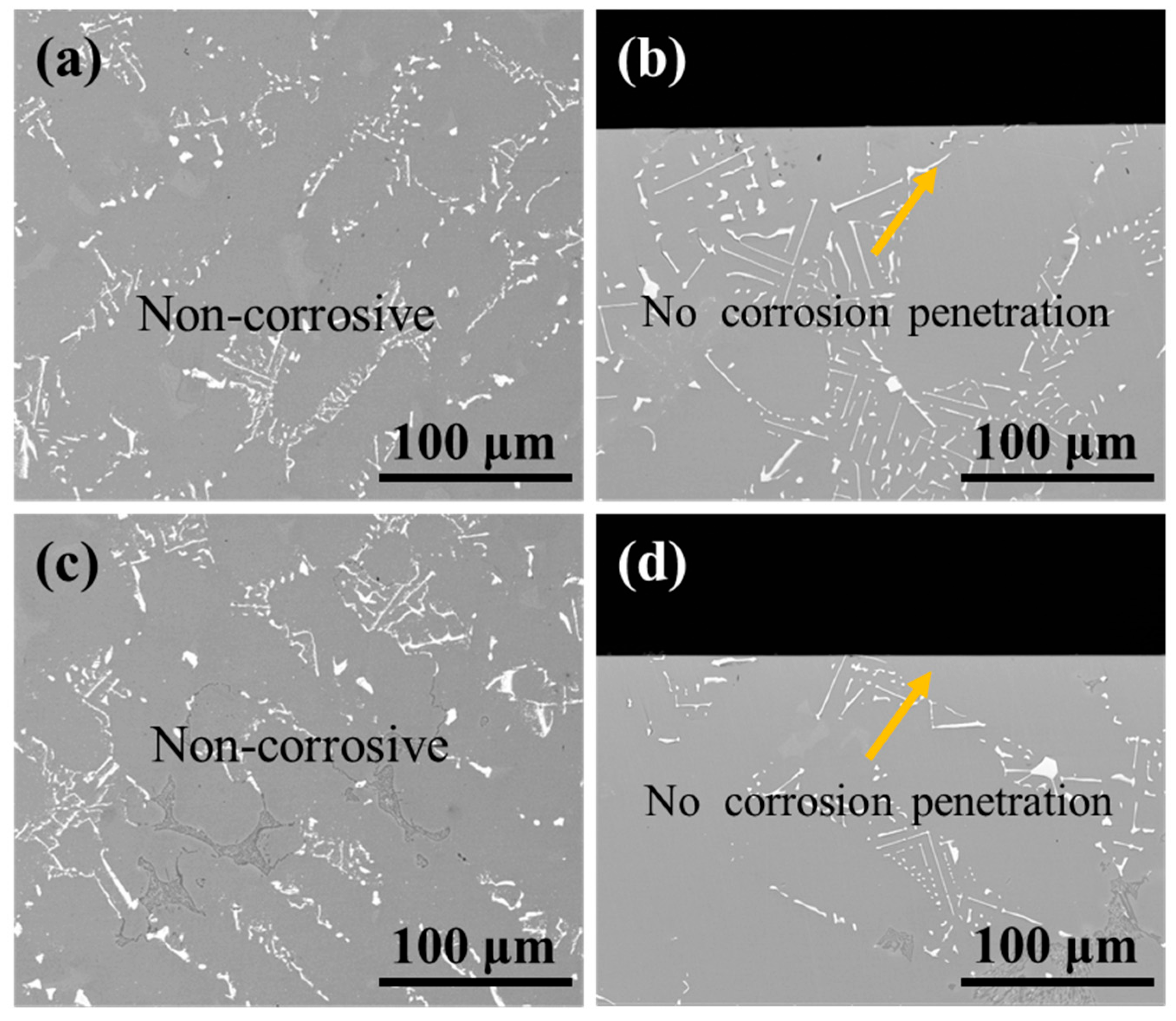
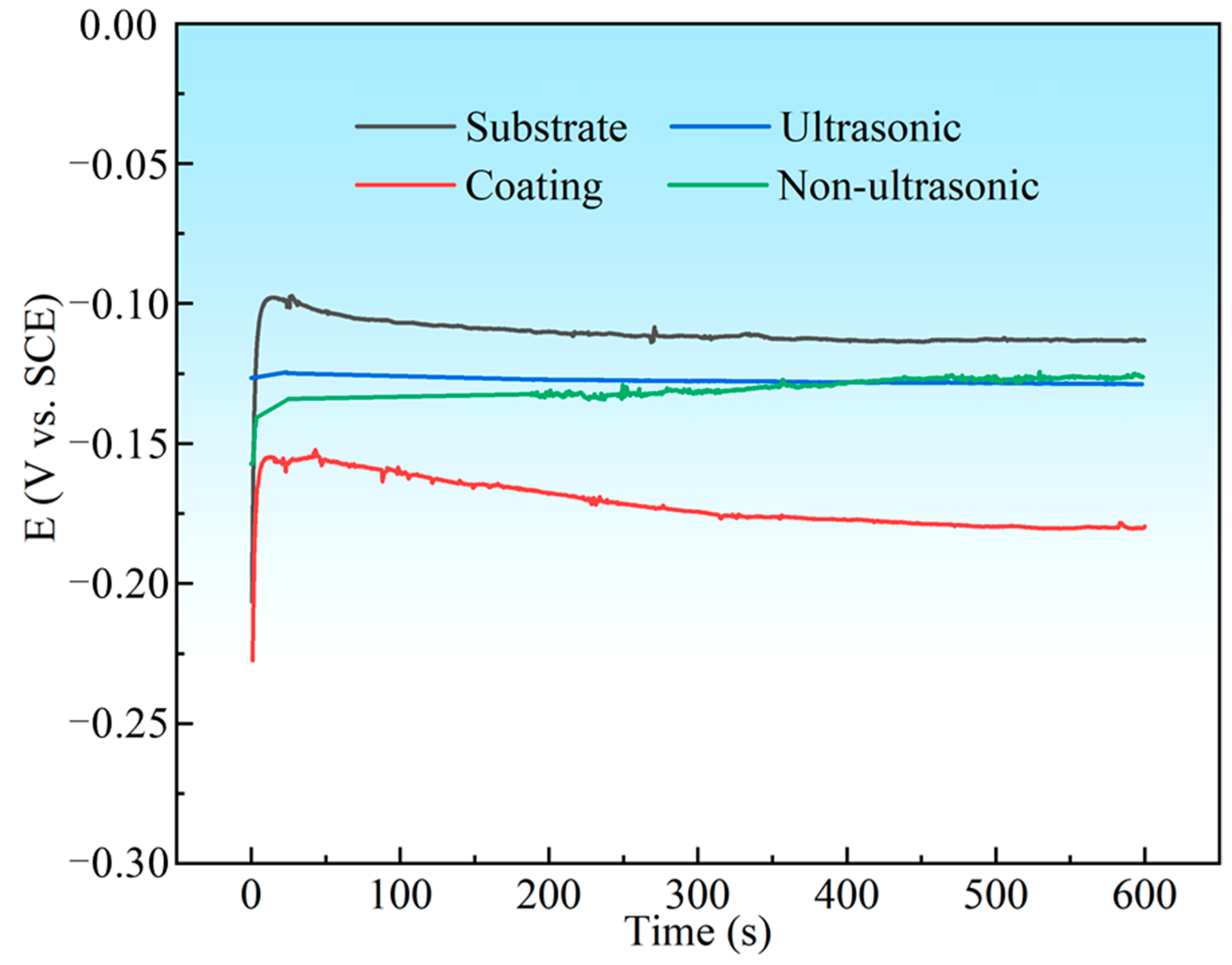
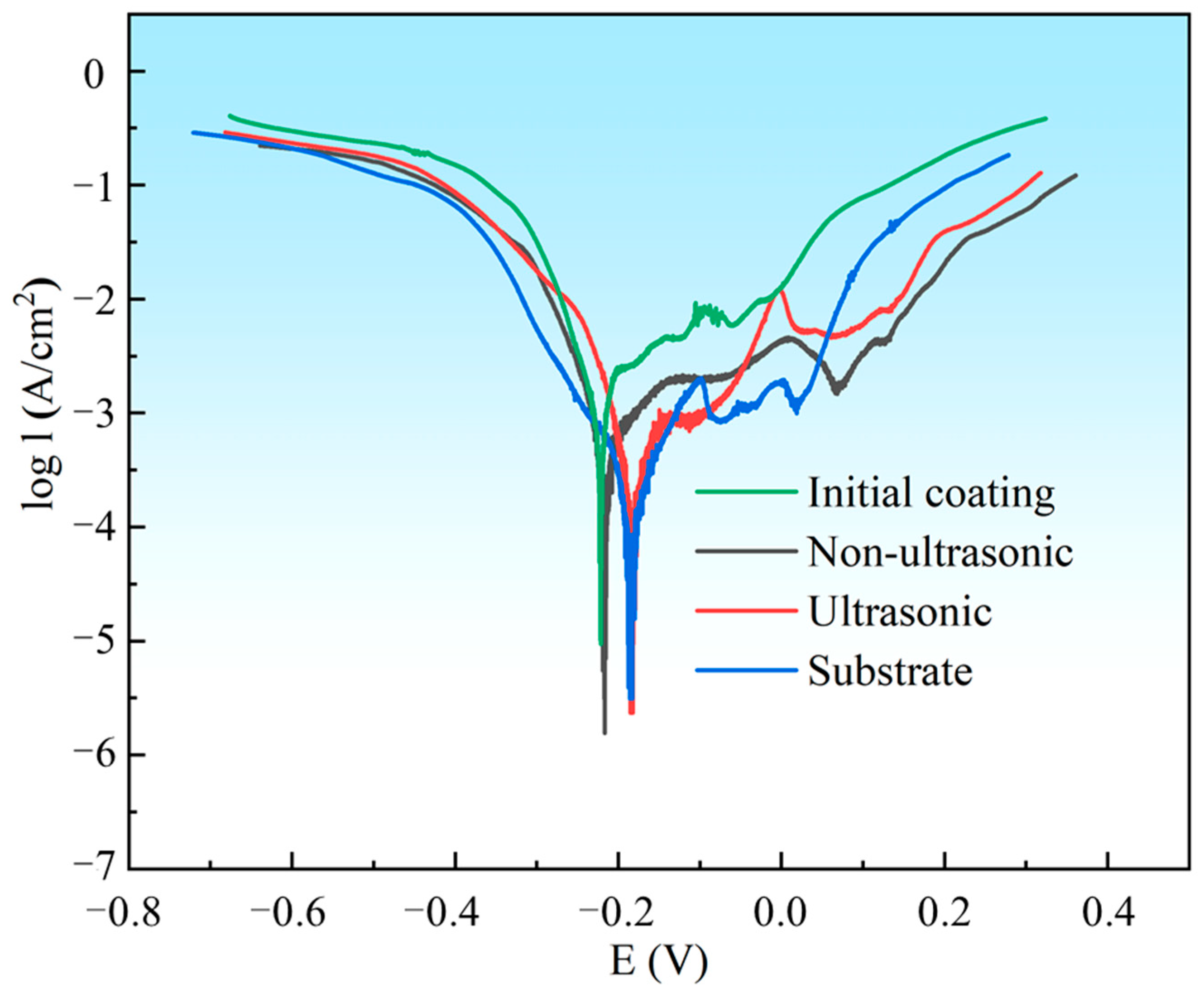

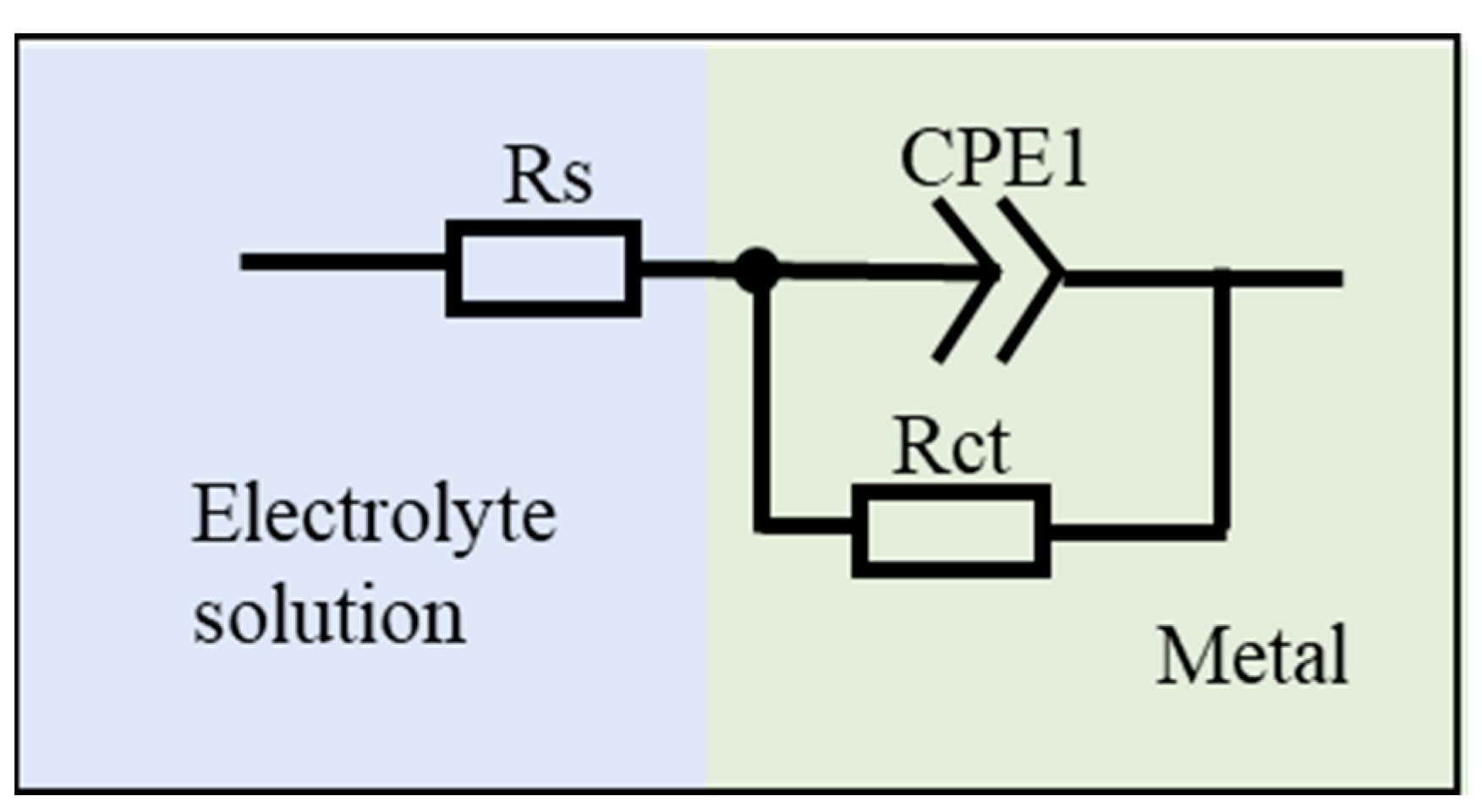


| Cr | Ni | W | Ta | C | Zr | Ti | Co |
|---|---|---|---|---|---|---|---|
| 23.0~24.0 | 9.0~11.0 | 6.5~7.5 | 3.0~4.0 | 0.55~0.65 | 0.3~0.6 | 0.15~0.25 | Bal. |
| Ecorr (V) | Icorr (A/cm2) | ||
|---|---|---|---|
| Before corrosion | Substrate | −0.1830 ± 0.0040 | (1.95 ± 0.13) × 10−4 |
| Initial coating | −0.2241 ± 0.0013 | (1.531 ± 0.110) × 10−3 | |
| After corrosion | Ultrasonic | −0.1826 ± 0.0028 | (1.57 ± 0.43) × 10−4 |
| Non-ultrasonic | −0.2285 ± 0.0050 | (4.734 ± 2.72) × 10−4 |
| Samples | Rs (Ω·cm−2) | CPE-T/10−5 (F·cm−2) | CPE-P (F·cm−2) | Rct/104 (Ω·cm−2) |
|---|---|---|---|---|
| Substrate | 71.8 ± 2.989 | 3.963 ± 0.150 | 0.888 ± 0.0099 | 3.457 ± 0.174 |
| Initial coating | 100.8 ± 7.356 | 16.14 ± 0.993 | 0.695 ± 0.0190 | 1.650 ± 0.232 |
| Ultrasonic | 95.15 ± 4.578 | 3.900 ± 0.171 | 0.914 ± 0.0138 | 7.395 ± 1.017 |
| Non-ultrasonic | 89.42 ± 7.865 | 3.138 ± 0.204 | 0.789 ± 0.0159 | 7.278 ± 1.163 |
Disclaimer/Publisher’s Note: The statements, opinions and data contained in all publications are solely those of the individual author(s) and contributor(s) and not of MDPI and/or the editor(s). MDPI and/or the editor(s) disclaim responsibility for any injury to people or property resulting from any ideas, methods, instructions or products referred to in the content. |
© 2025 by the authors. Licensee MDPI, Basel, Switzerland. This article is an open access article distributed under the terms and conditions of the Creative Commons Attribution (CC BY) license (https://creativecommons.org/licenses/by/4.0/).
Share and Cite
Jin, Y.; Xie, C.; Sun, K.; Li, Z.; Wang, X.; Ma, X.; Wang, H.; Shang, R.; Zhou, X.; Li, Y.; et al. Effect of Ultrasonic Treatment on Chemical Stripping Behavior of Aluminum Coating on K6509 Co-Based Superalloy. Materials 2025, 18, 3979. https://doi.org/10.3390/ma18173979
Jin Y, Xie C, Sun K, Li Z, Wang X, Ma X, Wang H, Shang R, Zhou X, Li Y, et al. Effect of Ultrasonic Treatment on Chemical Stripping Behavior of Aluminum Coating on K6509 Co-Based Superalloy. Materials. 2025; 18(17):3979. https://doi.org/10.3390/ma18173979
Chicago/Turabian StyleJin, Yuanyuan, Cheng Xie, Ke Sun, Zehuan Li, Xin Wang, Xin Ma, Hui Wang, Rongrong Shang, Xuxian Zhou, Yidi Li, and et al. 2025. "Effect of Ultrasonic Treatment on Chemical Stripping Behavior of Aluminum Coating on K6509 Co-Based Superalloy" Materials 18, no. 17: 3979. https://doi.org/10.3390/ma18173979
APA StyleJin, Y., Xie, C., Sun, K., Li, Z., Wang, X., Ma, X., Wang, H., Shang, R., Zhou, X., Li, Y., & Li, Y. (2025). Effect of Ultrasonic Treatment on Chemical Stripping Behavior of Aluminum Coating on K6509 Co-Based Superalloy. Materials, 18(17), 3979. https://doi.org/10.3390/ma18173979








